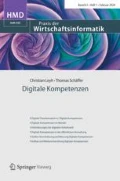Zusammenfassung
Im vorliegenden Beitrag wird ein plattformbasierter Lösungsansatz vorgestellt, der den Dialog von Domänenexperten und zukünftigen Anwendern im Rahmen der Entwicklung von Lösungen mit interdisziplinärem Mehrwert in domänenübergreifenden Anwendungsszenarien wesentlich verbessert. Die Plattform beinhaltet zur Abbildung domänenübergreifender Anwendungsszenarien und der Generierung interdisziplinärer Ideen und Lösungsansätze eine Kombination aus verschiedenen Living Labs, spezifischen Entwicklungsprozessen, entsprechender Software- und Hardware-Infrastruktur sowie einem eigens für die Plattform entwickelten Modell eines Living Lab-basierten Innovationsprozesses.
Abstract
The article introduces a platform approach, to improve the dialogue between domain experts and future users within the development of solutions with interdisciplinary benefit in cross-domain application scenarios. To realize cross-domain application scenarios and to generate interdisciplinary ideas and solutions, this platform combines different Living Labs, specific development processes, appropriate software and hardware infrastructure as well as a specifically developed model of a Living Lab-based innovation process.



Notes
Lead-User Workshops beschreiben Veranstaltungen, die Produkthersteller mit besonders innovativen Nutzern durchführen, um Ideen für bspw. die nächste Produktgeneration zu entwickeln. Lead User werden häufig anhand ihrer Aktivitäten in Foren und Communities identifiziert.
Siehe auch Abschn. 2.1.
Literatur
Ballon P, Pierson J, Delaere S (2005) Test and experimentation platforms for broadband innovation: examining European practice. In: Conference Proceedings of 16th European Regional Conference by the International Telecommunications Society (ITS), Porto, Portugal
Bergvall-Kareborn B, Stahlbrost A (2009) Living lab: an open and citizen-centric approach for innovation. Internation Journal Innovation Regional Development. 1(4):356–370
Bergvall-Kåreborn B, Ihlström Eriksson C, Ståhlbröst A, Svensson J (2009) A milieu for innovation – defining living labs. In: Bitran I, Conn S, Huizingh K, Torkkeli M (Hrsg) Proceedings of the 2nd ISPIM innovation symposium: simulating recovery – the role of innovation management, New York City, USA
Brandl S (2014) Open Innovation: Ein Vergleich zwischen Investitions- und Konsumgüterindustrie mit Praxisbeispielen von Siemens, Telefónica Germany, Krones, Maschinenfabrik Reinhausen, Strama-MPS und Hyve, Diplomica Verlag
Brem A, Voigt K-I (2009) Integration of market pull and technology push in the corporate front end and innovation management – insights from the German software industry. Technovation 29(5):351–367
Chesbrough H, Vanhaverbeke W, West J (2006) Open innovation: researching a new paradigm. Oxford University Press, Oxford
Eppinger E (2012) IP-und Patentmanagement in Open Innovation: Potenziale und Barrieren. Open Innovation in Life Sciences. (Hrsg) Braun A, Eppinger E, Vladova G, Adelhelm S. Gabler Verlag, Wiesbaden, S 83–98
Eriksson M, Niitamo VP, Kulkki S (2005) State-of-the-art in utilizing Living Labs approach to user-centric ICT innovation-a European approach. Lulea: Center for Distance-spanning Technology. Lulea University of Technology Sweden, Lulea
Geschka H (2006) Kreativitätstechniken und Methoden der Ideenbewertung. In: Sommerlatte T, Beyer G, Seidel G (Hrsg) Innovationskultur und Ideenmanagement – Strategien und praktische Ansätze für mehr Wachstum, Düsseldorf (Symposium), S. 217–249
Hellfeld S (2014) FZI house of living labs – interdisziplinärer Technologietransfer 2.0, Software Engineering 2014, Kiel, Germany
Mitchell WJ (2003) Me ++: the cyborg self and the networked city. MIT Press, Cambridge
Pallot M et al (2010) “Living lab research landscape: From user centred design and user experience towards user cocreation.” In Proceedings of the Living Lab Summer School, Paris, Cité des Sciences
Petre M (2005) How expert engineering teams use disciplines of innovation. Design Studies 25(5):477–493
Pohl T (2003) Die Integration von Kundenwissen in den Innovationsprozess. In: Nohr H (Hrsg) Customer-Knowledge-Management: Aspekte des Managements von Kundenwissen. Logos, Berlin, S 67–99
Reichart SV (2002) Kundenorientierung im Innovationsprozess – Die erfolgreiche Integration von Kunden in den frühen Phasen der Produktentwicklung. Springer-Verlag.
Rüggeberg H, Burmeister K (2008) Innovationsprozesse in kleinen und mittleren Unternehmen, Working Papers of the Institute of Management Berlin at the Berlin School of Economics (FHW Berlin), Nr. 41
Schaffers H et al (2007) “Exploring business models for open innovation in rural living labs.” 13th International Conference on Concurrent Enterprising, France
Schaffers H et al (2011) “Integrating living labs with future internet experimental platforms for co-creating services within smart cities.” IEEE 17th International Conference on Concurrent Enterprising (ICE)
Author information
Authors and Affiliations
Corresponding author
Rights and permissions
About this article
Cite this article
Hellfeld, S., Oberweis, A. & Wessel, T. Plattform zur prozessgetriebenen Entwicklung von anwenderinduzierten Innovationen in domänenübergreifenden Anwendungsszenarien. HMD 52, 337–346 (2015). https://doi.org/10.1365/s40702-015-0132-6
Received:
Accepted:
Published:
Issue Date:
DOI: https://doi.org/10.1365/s40702-015-0132-6

